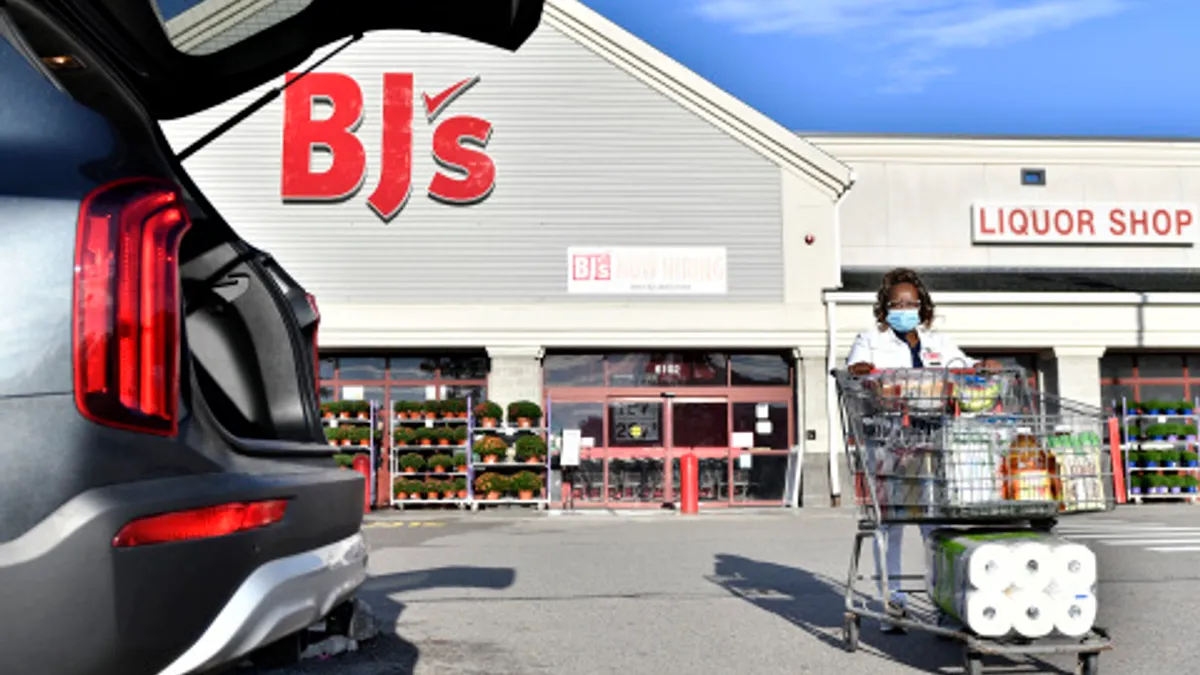Dive Brief:
- BJ's Wholesale Club has seen interest in its curbside pickup surge since launching the service chainwide in 2020, with more than half of online orders delivered through that channel in the fourth quarter, Robert Eddy, the club retailer's chief financial and administrative officer, said Wednesday during an investor conference hosted by UBS.
- BJ's has also recorded especially strong member-renewal rates in recent months, Eddy said. Members in their first year are renewing at a rate over 60%, up from the 50% level the retailer previously saw.
- The retailer has also been reaping the benefits of its emphasis on fresh foods, which has helped drive interest among consumers in shopping regularly at the retailer.
Dive Insight:
BJ's has made a concerted effort to enhance its digital infrastructure and has seen that effort pay off handsomely over the past year, Eddy said at the UBS Global Consumer and Retail Virtual Conference. The result has been an online business that is bringing in sales at five times the rate it did when the company went public in mid-2018, he said.
"Rewind the videotape four or five years and we didn't really have a website that could get out of its own way. We didn't have an app that solved anybody's problems," Eddy said. "We really just didn't have anything from which to work and spent a few years building all that infrastructure. And lo and behold, all you need is a pandemic and you get a thriving business on top."
BJ's decision to launch curbside pickup chainwide last August has been especially successful, Eddy said. Curbside has "been an overwhelming home run … that really impressed us. The speed of adoption has been quite amazing."
BJ's added curbside pickup after rival Sam's Club, which in June brought the option to all of its locations. But it was way ahead of Costco, which began a curbside pilot in January at three locations in New Mexico.
Eddy added that BJ's believes consumers see value in buying from the company online even with the added costs that come with using e-commerce channels.
"It looks potentially a little bit more expensive versus a traditional sale. But if you think about it as against [traditional grocers], they're saving 25, 30% on their order," Eddy said. "And then you subtract the delivery fee, they're probably still saving 15 to 20% on their order, and it's brought to their house. So [if they're] valuing their time at all, it looks like a good trade from their perspective."
BJ's is cautiously optimistic that the deeper engagement with customers it has built over the past year, particularly with those coming up for renewal, is likely to continue paying dividends, BJ's President and CEO Lee Delaney said on Tuesday during BofA Securities' Virtual Consumer & Retail Technology Conference.
"Every leading indicator of renewal that we typically would look at is flashing green, which we're very, very encouraged by," Delaney said. "But you know, the caveat to all of that is it is outside the norm of behavior. So while every measure looks great, we're going to find out over the course of the next four weeks to three months our ability to lap that cohort."
Delaney said BJ plans to maintain its heavy emphasis on fresh foods, which he said plays an essential role in attracting customers. "We know that fresh foods drive frequency of shop, and we need to make sure that we continue to offer a great assortment there. This is a place where we're happy to have a bit more choice than some of our competitors," Delaney said.
Speaking during the UBS event, Eddy said BJ's has also made progress in its private label business as a result of the unique conditions brought on by the COVID-19 crisis. For example, the company saw customers set aside brand preferences when shopping for hard-to-find items like paper goods as they turned to purchasing whatever brands the retailer was able to stock, he said.
BJ's wants to increase its private label penetration from its current level of about 21%, Eddy said, noting that component of its business has been going up at about 1% per year.










